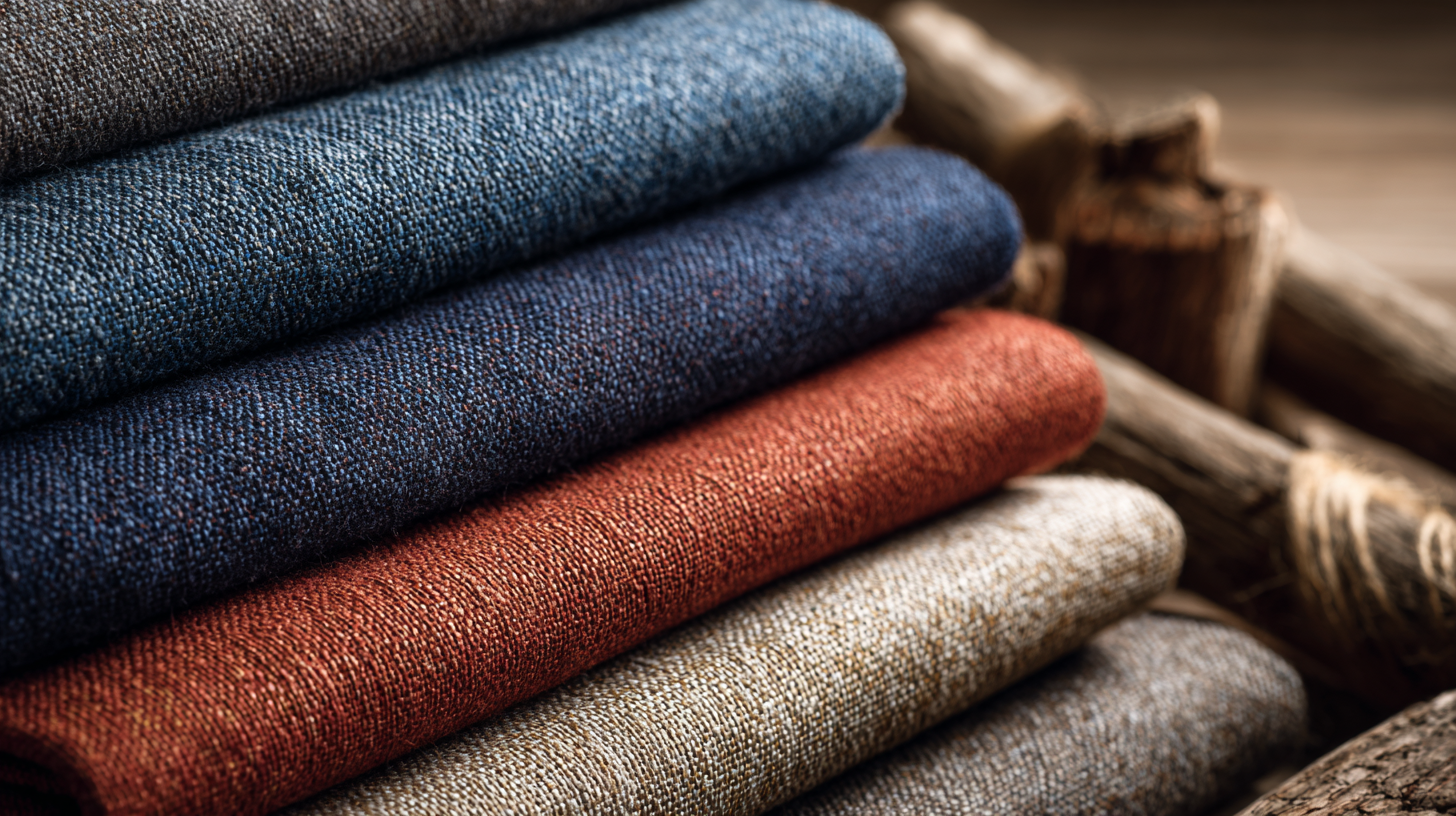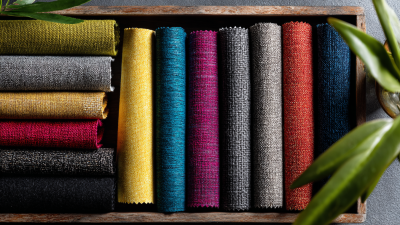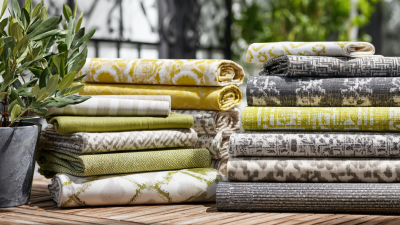Blog

Blog

Blog

Exploring the Benefits of Eco Friendly Outdoor Fabrics for Sustainable Living
As the global movement toward sustainable living gains momentum, the demand for eco-friendly outdoor fabrics has surged, capturing the attention of both consumers and manufacturers. According to a report by Grand View Research, the global eco-friendly fabric market is projected to reach $90.9 billion by 2025, driven by an increasing awareness of environmental issues and a desire for sustainable alternatives. Outdoor fabrics play a crucial role in this shift, offering not only durability and performance but also features that minimize environmental impact, such as being made from recycled materials or utilizing non-toxic dyes. By choosing eco-friendly outdoor fabrics, consumers can significantly reduce their carbon footprint while still enjoying the benefits of high-quality outdoor gear and furnishings. This article explores the myriad advantages of these sustainable textiles and provides practical tips for incorporating them into your outdoor lifestyle.

Understanding Eco-Friendly Outdoor Fabrics: Key Characteristics and Benefits
 Eco-friendly outdoor fabrics are revolutionizing the way we approach sustainable living by providing both durability and environmental responsibility. These fabrics are often made from recycled materials, such as post-consumer plastic bottles or leftover textiles, which significantly reduces landfill waste. According to a report from the Global Sustainability Textile Market, the eco-friendly segment is expected to grow by 25% annually, indicating a strong shift towards sustainable materials in outdoor gear. This transition not only helps mitigate environmental impact but also supports a circular economy where products are reused and recycled.
Eco-friendly outdoor fabrics are revolutionizing the way we approach sustainable living by providing both durability and environmental responsibility. These fabrics are often made from recycled materials, such as post-consumer plastic bottles or leftover textiles, which significantly reduces landfill waste. According to a report from the Global Sustainability Textile Market, the eco-friendly segment is expected to grow by 25% annually, indicating a strong shift towards sustainable materials in outdoor gear. This transition not only helps mitigate environmental impact but also supports a circular economy where products are reused and recycled.
In addition to their ecological benefits, these fabrics boast impressive performance characteristics. Many eco-friendly outdoor fabrics are treated to be water-resistant, UV-protective, and mold-resistant, ensuring longevity even in harsh conditions. The Outdoor Industry Association reports that consumers increasingly prefer products with sustainable certifications, underscoring the market demand for high-quality, responsibly sourced fabrics. By choosing eco-friendly options, consumers can reduce their carbon footprint while enjoying the comforts and performances of their outdoor gear.
Top 5 Sustainable Materials for Outdoor Fabrics and Their Environmental Impact
In the pursuit of sustainable living, eco-friendly outdoor fabrics play a crucial role, reducing not only environmental impact but also enhancing the longevity of outdoor gear. A report from the Sustainable Apparel Coalition highlights that choosing fabrics made from organic cotton over conventional cotton can decrease water usage by up to 90%. Organic cotton is free from harmful pesticides and synthetic fertilizers, making it a safer choice for both consumers and the planet.
Recycled polyester, another top contender, has emerged as a widely utilized sustainable material. According to the Ellen MacArthur Foundation, using recycled polyester can reduce carbon emissions by 70% compared to virgin polyester production. Additionally, materials such as hemp and Tencel are gaining recognition for their low environmental impact; hemp is known to grow rapidly and requires minimal water, while Tencel, derived from sustainably sourced wood pulp, boasts a closed-loop production process that minimizes waste and pollution. By opting for these eco-friendly materials, consumers can significantly contribute to sustainability efforts while enjoying durable and high-performance outdoor fabrics.
Tips for Choosing the Right Eco-Friendly Fabrics for Your Outdoor Projects
When it comes to selecting eco-friendly fabrics for outdoor projects, understanding the different options available is crucial for promoting sustainable living. According to a report by the Sustainable Furnishings Council, approximately 50% of all textiles produced globally are derived from synthetic materials, which not only contribute to environmental pollution but also have a significant carbon footprint. Opting for fabrics made from organic cotton, linen, or recycled materials can drastically reduce this impact. For instance, organic cotton uses 91% less water than conventional cotton, making it a more sustainable option for outdoor textiles.
Additionally, consider the durability and care requirements of the fabrics. Fabrics like hemp and Tencel are known for their resilience and biodegradability, offering both longevity and minimal environmental harm. A study by the Global Information Company indicates that using eco-friendly materials can decrease waste by up to 70% compared to traditional options. When selecting the right eco-friendly fabric, look for certifications such as Global Organic Textile Standard (GOTS) or OEKO-TEX, which ensure that the textiles are produced with environmentally friendly practices. By making informed choices, consumers can significantly contribute to a more sustainable approach to outdoor living.
Caring for Eco-Friendly Outdoor Fabrics: Maintenance Tips for Longevity
When it comes to maintaining eco-friendly outdoor fabrics, a little care goes a long way in ensuring their longevity and effectiveness. According to the Outdoor Industry Association, consumers are increasingly gravitating towards sustainable options, with a reported 76% of respondents willing to pay more for eco-friendly products. To keep these fabrics in top condition, regular cleaning is essential. Use mild, biodegradable soap and lukewarm water to remove dirt and stains, as harsh chemicals can degrade the material over time. It is also recommended to spot clean spills immediately and avoid machine drying, which may lead to shrinkage or damage.
In addition to cleaning, proper storage plays a crucial role in maintaining the quality of eco-friendly outdoor fabrics. A study from the Textile Research Journal indicates that UV exposure can significantly weaken fabric fibers, leading to fading and wear. Therefore, when not in use, store these items in a cool, dry place away from direct sunlight. Utilizing breathable storage bags can prevent moisture buildup, which is vital for avoiding mold growth. By implementing these maintenance tips, users can extend the life of their eco-friendly outdoor fabrics, contributing to a more sustainable lifestyle while enjoying the benefits of durable and stylish outdoor furnishings.
Exploring the Connection Between Sustainable Fabrics and Outdoor Lifestyle Choices
The connection between sustainable fabrics and outdoor lifestyle choices is increasingly significant as eco-friendly outdoor activities gain popularity in urban settings. The emergence of light outdoor scenes, such as suburban hiking and city strolls, reflects a growing trend where urban dwellers are seeking ways to relieve stress and reconnect with nature. As outdoor culture becomes a part of daily life, the demand for sustainable apparel that aligns with these experiences is on the rise.
Brands are recognizing this paradigm shift and responding with innovative collections that prioritize eco-friendly materials. This not only supports a more sustainable approach to living but also caters to the diverse needs of consumers who engage in outdoor activities. By embracing materials that are both high-performing and environmentally conscious, these brands contribute to a lifestyle that harmonizes with nature, encouraging individuals to make mindful choices about their clothing while enjoying the great outdoors.

Related Posts
-

Ultimate Guide to Selecting the Best Outdoor Fabrics for Global Procurement
-

Transform Your Patio: The Ultimate Guide to Choosing the Best Outdoor Fabrics
-

Common Issues Faced When Choosing Upholstery Fabrics for Your Furniture
-

Your Ultimate Guide to Choosing the Best Seat Fabric for Every Interior Style
-

Innovative Solutions for Enhancing Durability and Comfort in Furniture Fabric Selection
-

Understanding the Challenges with Choosing the Right Sofa Material
